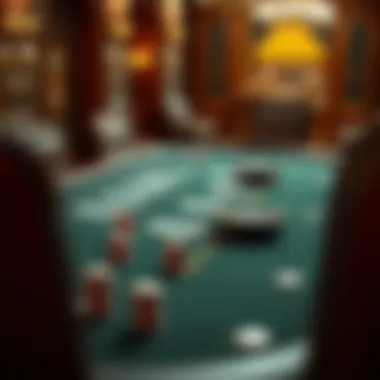Constructing a Poker Table: A Detailed Guide


Intro
Building a poker table from scratch can feel like venturing into deep waters without a life jacket. However, the thrill of crafting something unique, tailored to your specifications, is undeniably rewarding. This guide will serve as your anchor, walking you through the nuances of design, materials, and construction methods to ensure your poker table not only meets but exceeds expectations.
While you might think a table is just a flat surface to play on, the right table can dramatically change the experience of the game. It’s not merely about function; it’s about ambiance, aesthetics, and purpose. Whether you are a hobbyist or a seasoned player looking to set up a home game, the details involved in constructing your poker table are where the magic lies.
From selecting the right materials to considering the table's features and layout, we’ll explore every nook and cranny to ensure you’re well-equipped to create a masterpiece. If you're crankin' out a table for personal use or planning to cater to commercial needs, the knowledge gained here will empower your craftsmanship.
So grab your tools and let's navigate through this detailed guide. With each section, you’ll gain insights on what it takes to create a poker table that is both practical and visually appealing. Get ready to roll up your sleeves!
Understanding Poker Tables
Before diving headfirst into the construction process, it’s crucial to understand what types of poker tables exist and how they can impact gameplay. Let’s break them down:
- Traditional Poker Tables: These tables often feature a felt-covered playing surface and removable chips trays for an authentic poker environment.
- Folding Poker Tables: Perfect for homes with limited space, these tables can be easily stored away when not in use.
- Customizable Tables: Want a specific shape or size? Customizable tables allow for a personal touch that makes your table truly yours.
The right choice depends on your gameplay needs, personal style, and available space.
Materials Needed
Now that you’ve wrapped your head around the various types of poker tables, it’s time to consider the materials. Choosing the right materials is critical; they impact not just the table's durability, but also its feel and appearance. Here’s what you will typically need:
- Plywood or MDF: Used for the table's frame and surface. Choose a thickness that balances weight and sturdiness.
- Felt or Vinyl: The playing surface needs to be smooth. Felt provides a traditional touch, while vinyl is easier to clean.
- Wood or Metal Legs: Legs can be made from various materials depending on the sturdiness required.
- Padding: For comfort during long hours of play. Consider incorporating foam underneath the felt.
- Accessories: Chips, cards, and cups should all have designated spots, ensuring a clean gaming area.
Design Considerations
As you consider the design, think about how the table will fit within your space. Will it be a permanent fixture, or do you need it to be portable? Furthermore, how many players do you wish to accommodate? A standard table typically seats up to ten.
Incorporating features like a raised rail for chip storage, cup holders, or even personalized logos can enhance the experience. A well-designed table may even influence how many friends show up for game night!
"The best poker tables are ones that offer functionality without sacrificing style."
Final Thoughts
Building your own poker table is more than just a project; it’s an opportunity to meld creativity with functionality. It's a venture that can lead to many nights filled with competition and camaraderie. By understanding the intricacies involved—from types and materials to design—you lay the groundwork for a table that’s as unique as your poker strategy. Next, we will delve into construction techniques and tips to ensure your table withstands even the most intense of high-stakes games.
Prelude
Constructing your own poker table is not just a project; it's an experience. There’s something about creating a space meant for games of strategy, chance, and camaraderie that brings significance to the act itself. Whether you are an avid poker enthusiast, a casino manager looking to customize your gaming station, or a hobbyist eager to showcase your craftsmanship, the journey of making a poker table demands thoughtful consideration of numerous factors.
A poker table serves as the heart of a gaming session, where bonds are forged and memories created. Thus, understanding the elements involved in crafting one provides insights that stretch beyond mere construction. It’s about functionality, design, and personal touch. The right dimensions can affect gameplay, while the choice of materials can elevate the table’s aesthetic appeal.
Additionally, in a world where gaming experiences evolve, the incorporation of various poker table types, from traditional to modern foldable designs, cater to diverse needs. With so many options at hand, choosing the perfect table type can sometimes feel like a gamble itself.
This guide will delve into each significant aspect of building your own poker table—from the types of tables to the materials and design considerations. You’ll learn about the tools you need and the step-by-step processes that lead to a finished product you can be proud of. By the end of this comprehensive overview, you’ll be ready to not only construct a solid poker table but also ensure it reflects your unique style and serves the intended purpose effectively.
As we move forward, let’s take a closer look at the various types of poker tables, shedding light on their specific features and benefits, which will help you make an informed decision as you embark on this rewarding project.
Understanding Poker Table Types
Understanding the different types of poker tables is crucial for anyone looking to construct their own table, as each style serves unique purposes and complements various settings. Whether you're aiming for a casual game night at home or a more formal arrangement for professional play, knowing the distinctions between table types can greatly influence your design choices. The right table not only enhances the gaming experience but also adds a sense of style and functionality to your space.
Traditional Round Tables
Traditional round tables evoke a certain charm and intimacy, making them ideal for smaller groups or casual gatherings. The circular shape encourages a communal atmosphere, which can foster better engagement among players. Each player sits at an equal distance from one another, creating a sense of equality—no one is at the head of the table, so to speak. When considering dimensions, a good circular poker table typically spans 48 to 60 inches in diameter, accommodating six to eight players comfortably.
From aesthetics to functionality, traditional round tables can be constructed using various materials, ranging from solid hardwoods to plyboard. Opting for a plush, padded rim can enhance comfort during lengthy game sessions. However, take into account that the round design makes it less suitable for extensive tournaments frequently held at rectangular tables.
Rectangular Tables
Rectangular poker tables are arguably the most common choice in both home and professional settings. Their elongated shape allows for more players, usually accommodating up to ten or twelve participants, which is ideal for larger gatherings or tournament-style games. These tables often feature a dedicated dealer section and space for chips and cards, enhancing the overall organization during play.
Moreover, the design allows for efficient use of space, fitting neatly against walls or in corners when not in use. Common dimensions range from 72 to 96 inches long. When constructing a rectangular poker table, it’s important to ensure that the rail has ample padding and the felt is smooth to facilitate card playing.
Some might argue that rectangular tables lack the warmth of round ones, but their practicality often outweighs this concern, making them a popular choice among poker enthusiasts.


Folding Poker Tables
Folding poker tables have gained popularity swiftly due to their convenience and portability. Ideal for those who enjoy hosting impromptu game nights or travel frequently, these tables can be quickly set up and stored away without taking too much space. They usually come with a sturdy frame and a cushioned surface, balancing comfort with mobility.
These tables generally fit less players compared to traditional sizes, often seating four to eight, depending on the model. While they may not convey the luxurious feel of more permanent structures, their versatility makes them a practical option for many.
Folding tables can come in various finishes, often making them adaptable to any home decor. However, a consideration is that over time, the folding mechanisms can wear out, so ensure that durable materials are used to maintain longevity.
"The right poker table can make or break the experience you offer to your friends, so choose wisely!"
In summary, choosing the right type of poker table depends on your specific needs and preferences. Whether you lean towards a round, rectangular, or folding style, each brings unique benefits and charm to the poker-playing experience. Understanding these distinctions will guide you through the construction process and ensure that the final result meets both functional and aesthetic goals.
Materials Required for Construction
When it comes to constructing a poker table, the materials you choose play a pivotal role in determining the durability, functionality, and overall appearance of your creation. Selecting quality materials not only enhances the gaming experience but also ensures the longevity of the table. In this section, we will explore various materials necessary for building a poker table, breaking it down into wood choices, felt or cloth options, and table legs and structural support.
Wood Choices
Wood is certainly the backbone of any poker table. The type of wood you opt for can greatly affect both the table's aesthetics and its sturdiness. For instance, solid hardwoods like oak, maple, or cherry are popular choices due to their robustness. Oak is particularly valued for its resistance to scratches and dents, making it a great choice for a gaming surface that sees frequent use.
You might consider utilizing plywood for the interior components, as it provides strength without being excessively heavy. An important tip is to always strive for a consistent grain; this not only enhances beauty but also prevents warping over time. Remember, a well-crafted poker table doesn’t just look good; it stands the test of time.
Advantages of Solid Wood:
- Durability: Can withstand play and use over the years.
- Aesthetic Appeal: Offers a classic appearance that elevates any room.
- Customization: Easier to modify with stains or finishes to match your space.
Felt or Cloth Options
The playing surface of your poker table significantly affects the gaming experience. Choosing the right type of felt or cloth is essential. The most common selection is casino-grade polyester felt, which provides excellent slide for poker chips and cards. This kind of felt typically comes in various colors, letting you customize the look to match your personal style.
In addition to casino-grade felt, there are also options like wool felt that can provide a softer feel. When making your choice, consider the texture and thickness; thicker options might be more comfortable but could also increase the overall height of your table.
Tip: Always test the feel of the fabric before purchasing; a good quality felt should be soft yet durable, providing an enjoyable gaming experience.
Table Legs and Structural Support
Proper support is crucial for the integrity of the poker table. Choosing the right table legs and support structure is not to be overlooked. Solid wood legs are generally preferred as they can bear the weight of the play surface and withstand the vigorous action of game sessions. You may also look into swivel legs or adjustable-height legs if versatility is desired.
A cross-bracing system is another consideration. This crisscross framework connects the legs and helps prevent wobbling, providing added stability during gameplay.
Points to Consider:
- Material: Solid wood legs are more stable than metal for heavy gaming wear.
- Design: Sleek, tapered legs yield a modern look while sturdy legs offer a classic choice.
- Height: Ensure your table is built at a comfortable height to match typical gaming chairs.
In summary, each material chosen for your poker table plays an integral role in achieving not just functionality but also a refined look. A careful selection process will create an inviting atmosphere for both casual home games and more serious settings.
Design Considerations
In the world of poker tables, design considerations are not just purely aesthetic; they significantly impact the functionality and overall gaming experience. Crafting a poker table involves more than selecting materials and colors. Attention to the fine details can elevate a simple build into an exceptional centerpiece for any gaming occasion. Getting the design right ensures that players enjoy both comfort and style while engaging in their favorite card games.
Dimensions and Proportions
One cannot stress enough how crucial dimensions and proportions are when constructing a poker table. A table should be spacious enough to accommodate the gameplay without feeling cramped—this leads to a much more enjoyable experience. Generally, a standard poker table is about 78 inches long and 39 inches wide for an 8-player setup. However, the specific measurements can be adjusted based on your game’s requirements or even the space available.
When measuring, consider the height too. A typical height falls around 30 inches, allowing for comfortable seating. The key here is to ensure that the size fits the intended gameplay while allowing for easy maneuverability of the players around the table.
Seating Capacity
Seating capacity is tied closely to the dimensions of the poker table, but it warrants its own spotlight. Think about who will gather around the table. Is it for casual home games, or is it meant for more serious play? Flexible seating arrangements might be necessary if your games vary in size.
For instance, a round table can comfortably host six players, while rectangular tables can stretch to accommodate eight or even ten players. Ensuring your design can adapt to different group sizes will help maintain its utility over time. Don’t forget to account for adequate legroom—no one wants to feel like sardines when trying to bluff their way to a win.
Aesthetics and Finish
The aesthetics and finish of your poker table can reflect personal styles, while also creating an inviting atmosphere for play. From wood choices to paint finishes, every aspect of the interior and exterior design can hold sway over the ambiance. Consider going with a rich mahogany or cherry for that classic look, or perhaps a sleek modern finish.
When choosing the felt color, avoid opting for overly bright or loud colors that distract from gameplay. Instead, deeper shades like green or blue can enhance focus and create an air of sophistication. The finish not only adds to the visual appeal but also offers protection against spills or scratches. A high-quality lacquer can be a worthy investment, ensuring your table will withstand the test of time.


"Design isn’t just what it looks like and feels like. Design is how it works." - Steve Jobs
In summary, taking the time to carefully consider dimensions, seating capacity, and aesthetic qualities can significantly affect the final product. Make informed decisions that resonate with the intended use and desired player experience. Keep these aspects in mind as you visualize your poker table, and it might just become the crown jewel of your gaming setup.
Step-by-Step Construction Process
Building a poker table is more than just a hobbyist's activity; it's a journey that melds creativity, precision, and craftsmanship. This section lays out the crucial steps that guide you through the construction process, ensuring that each phase is not only manageable but also contributes to the final product's functionality and attractiveness.
Gathering Tools
Before you can even think about cutting wood or laying down cloth, having the right tools is essential. Each tool serves a unique purpose, and having them ready ensures a smoother assembly process later on. Essential tools include:
- Table saw: Vital for precision cuts, especially for larger wood pieces.
- Drill: Needed for making holes for screws, ensuring structural stability.
- Measuring tape: Accuracy is key, so you need to measure twice and cut once.
- Clamps: Helpful for holding pieces together as the glue dries or during assembly.
- Level: Ensures that the table will sit flat and not wobble when in use.
A well-stocked toolset will not only expedite the building process but also ensure quality construction, making sure your poker table stands the test of time.
Cutting the Wood
Once your tools are laid out, it’s time to cut the wood to suit your design. The wood pieces must align with the dimensions established in earlier sections. Precision is non-negotiable here. Here’s how to go about it:
- Measure carefully the dimensions for the tabletop and the legs. Mark your cuts using a pencil for visibility.
- Use the table saw to execute smooth cuts on your marked lines. Keep the board steady, and let the saw do the work without forcing it.
- Sand the edges after cutting to prevent splinters and ensure smooth surfaces that will look great once assembled.
A clean cut is crucial. It means your table won't just look good — it will hold together well when you finally put it all together.
Assembling the Frame
With your pieces cut, it’s now time to assemble the frame. This step lays the foundation for your poker table’s durability and stability.
- Start by laying out the pieces on a flat surface. Ensure everything fits as expected.
- Use clamps to hold the pieces in place as you secure them with screws. This helps prevent movement during the fastening process.
- Make sure everything is squared up; corners should be 90 degrees. A misaligned frame can lead to issues later on, especially when you add the tabletop.
A solid frame will carry the weight of the poker table and players without any risk of collapsing.
Installing the Felt
A poker table isn’t complete without its felt covering. This is where the game comes to life, making it both functional and inviting for players. Here’s how to install it:
- Cut the felt to size; it should extend slightly beyond the edges of the table to ensure complete coverage.
- Adhesive spray or double-sided tape can be used. Make sure you apply it evenly across the surface.
- Starting from one side, carefully lay the felt down, smoothing out air bubbles as you move along.
- Once fully laid down, trim excess felt along the edges for a neat finish.
A well-installed felt not only enhances the beauty of your table but also significantly improves gameplay by providing a smooth surface for cards and chips.
Finishing Touches
Now it’s time for those finishing touches that make your poker table uniquely yours.
- Stain or paint the wood: Choose a finish that complements your decor and protects the wood.
- Install cup holders: This small addition can make a big difference in comfort during long gaming sessions.
- Consider adding LED lights beneath the table for a fun ambiance during night games.
These final steps tie everything together, creating a table that’s both aesthetically pleasing and functional.
"A great poker table is built with care, reflecting not just skill, but the heart of the game itself."
In totality, each step of this construction process is crucial in bringing your vision of a poker table to life. Diligence during these phases ultimately culminates in a centerpiece for your gaming nights, showcasing not just works of craftsmanship but also your personal touch.
Customizing Your Poker Table
Customizing your poker table is where your personality starts to shine through the construction process. It's not just a place to deal cards; it's a statement piece that reflects your style and enhances your playing experience. Whether you are hosting casual games with friends or organizing more serious matches, tailored designs can elevate the atmosphere significantly.
When considering customization, think about the overall vibe you want to create. It’s essential to balance aesthetics and functionality. A well-designed table should not only look pleasing but also cater to the requirements of the game. Elements such as surface materials, color schemes, and additional features can affect gameplay dynamics and comfort immensely.
Personalized Designs
One of the most rewarding aspects of building your poker table is the opportunity for personalized designs. You can choose colors and patterns that resonate with you, ensuring that the table fits well within your home or gaming space.
Consider the following elements when personalizing:
- Color Scheme: Choose a color that either matches your living room decor or stands out as a unique piece. Some players like a bold red or green; others might prefer a subtler look.
- Inlaid Designs: Think about incorporating inlays like logos or personal insignias into the felt or wood surface. This could be anything from your initials to patterns that have personal significance.
- Lighting Features: Adding LED strips around the edges of the table can create a cool ambiance. It can also help with visibility during late-night games.
Personalizing your poker table is about making it uniquely yours. It’s an opportunity to infuse your character and preferences, transforming a simple table into an intricate part of your gaming journey.


Incorporating Technology
As we move forward in the digital age, integrating technology into the poker table has become a popular trend. This can range from simple enhancements to more complex installations. The goal here is to enhance the gaming experience while maintaining the table's aesthetic charm.
Here are some tech-savvy ideas:
- Built-in Electrical Outlets: Having outlets can be a lifesaver for long gaming sessions. Players can charge their devices without disrupting the game.
- Smart Sensors: For those keen on innovation, installing sensors can help track bets and automate scoring, leading to a smoother gameplay experience.
- Interactive Displays: Incorporating a screen to display information such as tournament statistics, player rankings, or even a scoreboard can keep players engaged and informed.
Using technology means that you are not just building a table; you're creating a multifunctional piece that can adapt to the modern gamer's needs. It can impress your peers and enhance your personal enjoyment of games, merging tradition with contemporary style.
Remember, customizing your poker table is not just a task; it’s an adventure that allows you to express your individuality while creating a perfect product for entertaining friends or engaging in serious play.
Maintenance of the Poker Table
Maintaining a poker table is crucial for ensuring its longevity and functionality. A poker table sees a lot of action, from friendly home games to serious tournaments, making the upkeep a necessary task. Regular maintenance not only prevents wear and tear but also maintains the aesthetic integrity of the table, allowing it to shine during gatherings and events.
Despite the table being a focal point of excitement and competition, it can also become a victim of stains, scratches, and general damage. Ensuring it's in prime condition helps create an enjoyable playing experience. By dedicating time and effort to its care, you can extend its life and keep it looking sharp.
Cleaning and Care Tips
Keeping your poker table clean is essential for maintaining its appearance and durability. Here are some tips to consider:
- Use Soft Cloths: Always start with a soft cloth to wipe down the surface. Avoid rough materials that can scratch or damage the felt or wood.
- Spot Cleaning: Deal with spills immediately. Use a slightly damp cloth with mild soap to blot the area instead of rubbing it. This can prevent stains from settling.
- Vacuum Regularly: Use a hand-held vacuum or a gentle brush to remove crumbs or dirt from the felt surface. This can help maintain its integrity and appearance.
- Avoid Harsh Chemicals: Be cautious with cleaning products. Stay away from strong solvents that can strip the finish or damage the cloth. Often, simple warm water is enough to do the job without risk.
- Condition the Wood: If the table has a wooden surface, consider applying a wood conditioner from time to time. It helps protect against moisture and keeps the wood looking good.
"Prevention is better than cure." A little attention can save you a lot of trouble down the line.
Repairing Common Issues
Over time, your poker table may face its share of challenges. Here are some common issues and how to tackle them:
- Loose Legs: If a leg feels wobbly, it could be a sign of wear or looseness. Tighten screws or bolts to secure the structure. If the leg is cracked, consider using wood glue, allowing it the time needed to dry before putting weight back onto it.
- Padded Areas: If the padding is wearing down, look into replacing the foam or felt. It may be a bit of work, but restoring those areas brings back comfort for players.
- Scratches or Dents: For minor scratches on wooden surfaces, a simple wood filler can often do the trick. Choose a color that matches your table closely, applying it with care to keep a smooth finish.
- Felt Peeling or Ripping: If the felt begins to peel or rip, it may be time to re-cover it. Remove the old felt gently, and ensure the surface beneath is clean before applying a new layer.
- Stains: For tougher stains that won’t budge, try a dedicated upholstery cleaner that's compatible with if your felt is synthetic. Always test a small area first to ensure it won't damage or discolor the material.
Addressing these issues promptly can prevent further damage and enhance your gaming experience, keeping your poker table in tip-top shape for years to come.
Poker Table Usage
Understanding how to effectively utilize your poker table transcends mere ownership. Whether you're a casual player or operating in a professional framework, knowing how to make the best out of your poker environment is paramount. This section will delve into two primary usages: home games and professional settings, each having its specific nuances and arrangements. By exploring these aspects, it can help not only in enhancing the play experience but also in ensuring that the table fulfills its intended purpose.
Home Games
Home poker games carry a unique charm and community vibe that simply cannot be replicated in larger venues. Hosting these games usually involves setting the mood just right. You want your players to feel relaxed, yet focused on the game. Comfortable seating, adequate lighting, and an inviting atmosphere can significantly elevate the experience.
A round table might be preferred here, as it facilitates conversation and camaraderie. Keeping snacks and drinks within reach is beneficial too; it can actually prolong your game night and keep spirits high. Here are some aspects to consider when you’re setting up home games:
- Game Variety: Offer a mix of poker styles, from Texas Hold'em to Omaha, catering to different preferences.
- Set Rules: Clarity in house rules prevents confusion and disputes during play.
- Player Mix: Invite a diverse group of friends; varying skill levels can lead to more dynamic and enjoyable games.
Using decorations or themes based around popular poker culture can add an extra layer of fun. You might put up a few posters of famous poker personalities or even use themed playing cards to keep the ambiance lively. Engagement and communication are vital to a successful home poker experience, essentially creating an environment that mixes competition with community.
Professional Settings
In contrast, professional poker settings are governed by more structured protocols and requirements. Whether it’s in a casino or at a prestigious tournament, the emphasis is heavily on competitive integrity and the overall gameplay experience. Here are important elements to consider:
- Table Specifications: Professional poker tables often have standardized dimensions to ensure parity among players. Each player should have adequate space to play effectively.
- Equipment Quality: Casino settings will employ high-quality felt and croupier materials. Investing in superior materials not only helps in gameplay but elevates the visual appeal.
- Surveillance and Security: Cameras and monitoring systems are essential to maintain fairness and to deter potential cheating.
Considering how poker is often viewed as both an art and a sport, the environment can significantly influence performance. A well-constructed poker table in a professional setting is often designed for function but also reflects the prestige of the event. Players should feel the excitement and tension in the air, almost like an athlete walking into a stadium.
Who knew that the subtle details of table construction could make such a big difference? A thorough understanding of poker table usage is not merely about what happens on the felt, but how the setting impacts the gameplay.
In summary, whether you're arranging a friendly game in your living room or gearing up for a high-stakes tournament, recognizing the nuances of usage will amplify the poker experience for all involved. The effort put into table specifications, seating arrangements, and atmosphere can define the quality of play, making every session memorable.
Ending
In wrapping up this extensive guide on constructing a poker table, it’s essential to recognize the multifaceted value of this endeavor. A poker table is not just a piece of furniture; it embodies the spirit of camaraderie and competition found in the game. Understanding how to create or customize a poker table amplifies the overall experience for players, turning casual gatherings into unforgettable events.
One of the primary benefits of building your own poker table lies in the ability to tailor it to your specific needs. You’re in control of each choice, from the size and shape of the table to the materials used. For instance, opting for a plush velveteen felt might enhance card sliding, while a more textured surface could lend to a more rustic feel. Every decision impacts not just aesthetics but also the functionality of the table.
Moreover, correctly applying the skills discussed in this article ensures your poker table is built to last. Considering the design aspects discussed—like making sure the legs provide sufficient support and the height is appropriate for casual comfort—will go a long way in maintaining the integrity of the table over the years.
"A custom poker table isn't just about style; it’s about crafting memories over the felt."
Beyond the practical elements, customization allows you to showcase your personality. Whether it’s an engraved nameplate, team colors, or built-in tech, a personalized poker table reflects you and your gaming philosophy.
Lastly, as argued throughout this guide, attention to maintenance is crucial. A well-maintained poker table not only looks great but also invites players to gather more often. Regular cleaning procedures, along with simple repairs covered in earlier sections, will ensure this center piece remains the talking point of your game nights.















